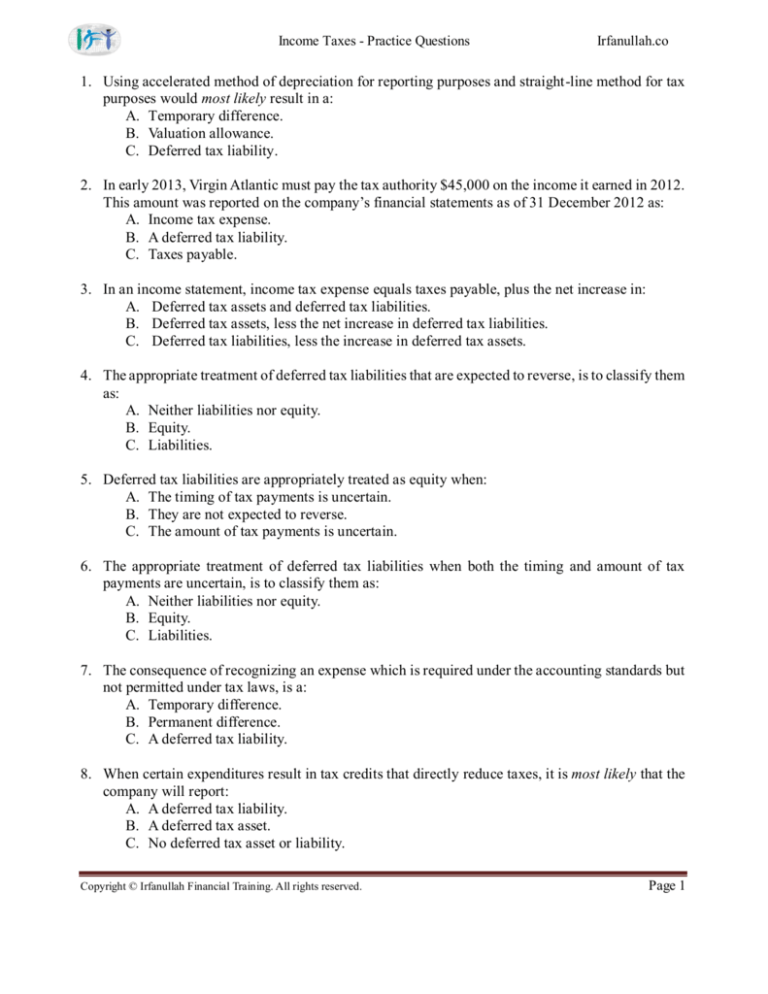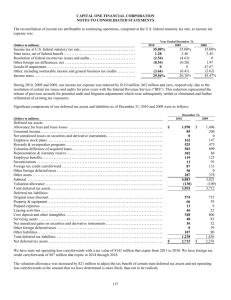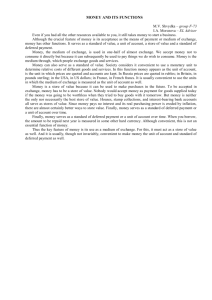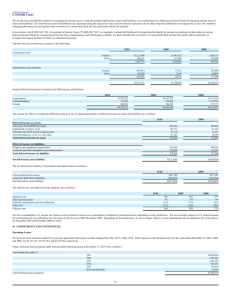
Income Taxes - Practice Questions
Irfanullah.co
1. Using accelerated method of depreciation for reporting purposes and straight-line method for tax
purposes would most likely result in a:
A. Temporary difference.
B. Valuation allowance.
C. Deferred tax liability.
2. In early 2013, Virgin Atlantic must pay the tax authority $45,000 on the income it earned in 2012.
This amount was reported on the company’s financial statements as of 31 December 2012 as:
A. Income tax expense.
B. A deferred tax liability.
C. Taxes payable.
3. In an income statement, income tax expense equals taxes payable, plus the net increase in:
A. Deferred tax assets and deferred tax liabilities.
B. Deferred tax assets, less the net increase in deferred tax liabilities.
C. Deferred tax liabilities, less the increase in deferred tax assets.
4. The appropriate treatment of deferred tax liabilities that are expected to reverse, is to classify them
as:
A. Neither liabilities nor equity.
B. Equity.
C. Liabilities.
5. Deferred tax liabilities are appropriately treated as equity when:
A. The timing of tax payments is uncertain.
B. They are not expected to reverse.
C. The amount of tax payments is uncertain.
6. The appropriate treatment of deferred tax liabilities when both the timing and amount of tax
payments are uncertain, is to classify them as:
A. Neither liabilities nor equity.
B. Equity.
C. Liabilities.
7. The consequence of recognizing an expense which is required under the accounting standards but
not permitted under tax laws, is a:
A. Temporary difference.
B. Permanent difference.
C. A deferred tax liability.
8. When certain expenditures result in tax credits that directly reduce taxes, it is most likely that the
company will report:
A. A deferred tax liability.
B. A deferred tax asset.
C. No deferred tax asset or liability.
Copyright © Irfanullah Financial Training. All rights reserved.
Page 1
Income Taxes - Practice Questions
Irfanullah.co
9. When accounting treatment of an asset requires it to be expensed immediately whilst tax rules
require it to be capitalized and amortized, it is most likely that the company will report:
A. A deferred tax liability.
B. A deferred tax asset.
C. No deferred tax asset or liability.
10. When a capital expenditure is incurred with a depreciation period set for seven years for
accounting purposes but six years for tax purposes, it is most likely that the company will report:
A. A deferred tax liability.
B. A deferred tax asset.
C. No deferred tax asset or liability.
11. For tax purposes, a company treats advance payments from customers as immediately taxable but
for accounting purposes the advance payments are not recognized until the company’s obligation
is fulfilled. It is most likely that the company will report:
A. A deferred tax liability.
B. A deferred tax asset.
C. No deferred tax asset or liability.
The following information relates to Questions 12-14
Note I
Income Taxes
The components of earnings before income taxes are as follows ($ thousands):
2012
2011
2010
Earnings before income taxes:
United States
$67,004
$57,505
$45,583
Foreign
80,533
78,328
65,390
Total
$147,537
$135,833
$110,973
The components of the provision for income taxes are as follows ($ thousands):
2012
2011
Income Taxes
Current:
Federal
$17,109
$12,305
Foreign
15,143
17,067
$32,252
$29,372
Deferred:
Federal
($3,220)
$3,482
Foreign
4
222
($3,216)
$3,704
Total
$29,036
$33,076
Copyright © Irfanullah Financial Training. All rights reserved.
2010
$10,589
13,589
$24,178
$1,583
379
$1,962
$26,140
Page 2
Income Taxes - Practice Questions
Irfanullah.co
12. The company’s U.S. GAAP income statement in 2012 reported a provision for income taxes
closest to:
A. $29,036.
B. $17,109.
C. $32,252.
13. The effective tax rate of the company was highest in:
A. 2010.
B. 2011.
C. 2012.
14. In comparison to the company’s effective tax rate on US income, its effective tax rate on foreign
income was:
A. Lower in each reporting year.
B. Higher in each reporting year.
C. Lower in some years and higher in others.
15. National Inc. follows U.S. GAAP to report its financial statements. In 2005, National records a
valuation allowance of $3,905 against total deferred tax assets of $21,764. In 2004, National
recorded a valuation allowance of $2,870 against total deferred tax assets of $18,980. The change
in the valuation allowance most likely reflects that National’s:
A. Deferred tax liabilities were increased in 2005.
B. Expectations of future earning power have increased.
C. Expectations of future earning power have decreased.
16. APL Corp reported a total deferred tax asset in 2009 of $45,189, offset by a $45,189 valuation
allowance. APL Corp most likely:
A. Has deferred tax assets equal to deferred tax liabilities.
B. Fully utilized the deferred tax asset in 2009.
C. Expects not to earn any taxable income before the deferred tax asset expires.
The following information relates to Questions 17-19
The tax effects of temporary differences that give rise to deferred tax assets and liabilities are as
follows ($ thousands):
Deferred tax assets:
Accrued expenses
Tax credit and net operating loss carry forwards
LIFO and inventory reserves
Other
Deferred tax assets
Valuation allowance
Net deferred tax assets
Copyright © Irfanullah Financial Training. All rights reserved.
2011
2010
$9,175
1,378
4,876
1,976
17,405
(2,236)
$15,169
$7,190
2,536
3,784
1,534
15,044
(2,945)
$12,099
Page 3
Income Taxes - Practice Questions
Deferred tax liabilities:
Depreciation and amortization
Compensation and retirement plans
Other
Deferred tax liabilities
Net deferred tax liability
Irfanullah.co
2011
2010
$(25,157)
(4,532)
(910)
(30,599)
($15,430)
$(28,250)
(8,925)
(413)
(37,588)
($25,489)
17. An increase in the statutory tax rate would most likely hurt the company’s:
A. Income statement and balance sheet.
B. Only income statement but not the balance sheet.
C. Only balance sheet but not the income statement.
18. Had the valuation allowance been the same in 2011 as it was in 2010, the company would have
reported higher:
A. Net income.
B. Income tax provision.
C. Deferred tax assets.
19. In comparison to the income tax provision in 2011, the company’s tax payments in cash were:
A. The same.
B. Lower.
C. Higher.
The following information relates to Questions 20-22
A company’s provision for income taxes resulted in effective tax rates attributable to loss from
continuing operations before cumulative effect of change in accounting principles that varied from
the statutory federal income tax rate of 30 percent, as presented in the table below.
Year Ended 31 Dec
Expected federal income tax expense (benefit) from
continuing operations at 30 percent
Expenses not deductible for income tax purposes
State income taxes, net of federal benefit
Change in valuation allowance for deferred tax
assets
Income tax expense
2012
2011
2010
($120,000)
$850,000
$785,000
410,000
122,000
39,000
25,000
45,000
78,000
(145,000)
(844,000)
(839,000)
$267,000
$70,000
$69,000
20. The company’s net income (loss) in 2012 was closest to:
A. ($227,000).
B. ($400,000).
Copyright © Irfanullah Financial Training. All rights reserved.
Page 4
Income Taxes - Practice Questions
Irfanullah.co
C. ($667,000).
21. In 2012, the $410,000 adjustment most likely resulted in:
A. An increase in deferred tax assets.
B. An increase in deferred tax liabilities.
C. No change in deferred tax assets and liabilities.
22. The changes in valuation allowance for deferred tax assets over the given period of three years
were most likely indicative of:
A. Increased prospects for future profitability.
B. Decreased prospects for future profitability.
C. Assets being carried at a higher value than their tax base.
Copyright © Irfanullah Financial Training. All rights reserved.
Page 5
Income Taxes - Practice Questions
Irfanullah.co
Solutions
1: A
The resulting deferred tax asset arising from the differences between tax and financial reporting will
correct over time and will be a temporary difference. A valuation allowance would arise only if there
was if there was doubt on the company’s ability to earn sufficient future income required to pay the
tax.
2: C
Taxes payable are the taxes that a company must pay in the immediate future.
3: C
Higher reported tax expense in comparison to taxes paid will increase the deferred tax liability
whereas lower reported tax expense in comparison to taxes paid will increase the deferred tax asset.
4: C
The deferred tax represents a future liability if the liability is expected to reverse and therefore
requiring a cash tax payment in future.
5: B
The deferred tax represents equity if the liability is not expected to reverse and therefore requiring no
tax payment in future.
6: A
The deferred tax should neither be treated as liability or equity when both the amounts and timing of
tax payments resulting from the reversals of temporary differences are uncertain.
7: B
Accounting items that are not deductible for tax purposes will not be reversed and therefore result in
permanent differences.
8: C
Tax credits that directly reduce taxes are a permanent difference and permanent differences do not
lead to deferred tax.
9: B
The capitalization will result in an asset with a positive tax base and zero carrying value. Amortization
means that the difference is temporary. A deferred tax asset is created since there is a temporary
difference on an asset resulting in a higher tax base than carrying value.
10: A
A deferred tax liability is created because the difference is temporary and the tax base will be lower
(consequent to more rapid depreciation) than the asset’s carrying value.
11: B
Copyright © Irfanullah Financial Training. All rights reserved.
Page 6
Income Taxes - Practice Questions
Irfanullah.co
A deferred tax asset is created since the advances from customers (liability) exceed the tax base
(which is now zero).
12: A
The income tax provision for 2012 was $29,036, consisting of $32,252 in current income taxes, of
which $3,216 were deferred.
13: B
The effective tax rate of 24.4 percent ($33,076/$135,833) was higher than the effective rates in 2010
and 2012.
14: A
In 2012, the effective tax rate on foreign operations was 18.8% and the effective U.S. tax rate was
20.7%. In 2011, the effective tax rate on foreign operations was 22.1% and the effective U.S. tax rate
was 27.5%. In 2010, the effective tax rate on foreign operations was 21.4% and the effective U.S. tax
rate was 26.7%.
15: C
The valuation allowance is taken against deferred tax assets to represent the uncertainty that future
taxable income will be sufficient to fully recover the assets. By increasing the allowance, National
Inc. is indicating greater probability that future earnings not will be offset by the deferred tax asset.
16: C
The valuation allowance is taken when there is a greater likelihood that the company will fail to earn
sufficient income to offset the deferred tax asset. Since the valuation allowance equals the asset, by
extension the company expects no taxable income prior to the expiration of the deferred tax assets.
17: A
A higher tax rate would decrease net income on the income statement and because the company has
a net deferred tax liability, the net liability position on the balance sheet would also worsen (be
higher).
18: B
If the valuation allowance in 2011 was 2,945 (same as the 2010) rather than 2,236, the company
would report lower net income. Recall that high valuation allowance can be thought of as high
depreciation which results in lower income. Hence option A is not correct. A higher valuation
allowance would result in a lower DTA, hence option C is not correct. A lower DTA means that the
income tax expense (also called income tax provision) is higher.
19: C
The net deferred tax liability was smaller in 2011 than in 2010 representing that besides meeting the
tax payments provided for in 2011 the company also paid out taxes that had been deferred in earlier
years.
20: C
Copyright © Irfanullah Financial Training. All rights reserved.
Page 7
Income Taxes - Practice Questions
Irfanullah.co
The income tax benefit at the statutory rate of 30 percent is $120,000, indicating that the pre-tax
income was a loss of $120,000/0.30 = ($400,000). The income tax provision was $267,000. The
company’s net loss in 2012 is ($400,000) - $267,000 = ($667,000).
21: C
Accounting expenses that are not deductible for tax purposes lead to permanent difference and
therefore do not give rise to deferred taxes.
22: A
Over the given time period, changes in valuation allowance reduced aggregate income taxes by
$1,828,000. The reductions to the valuation allowance were a result of the company being more likely
to earn sufficient taxable income to offset the deferred tax assets.
Copyright © Irfanullah Financial Training. All rights reserved.
Page 8







